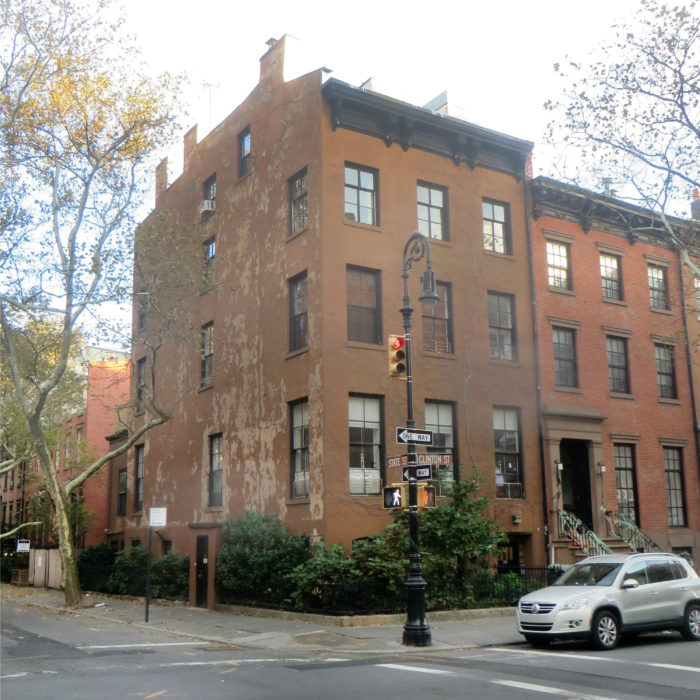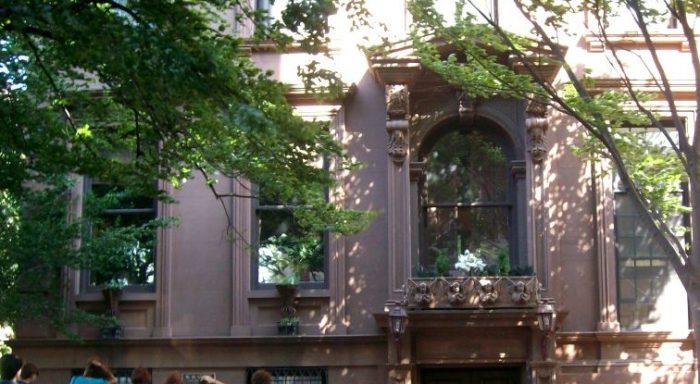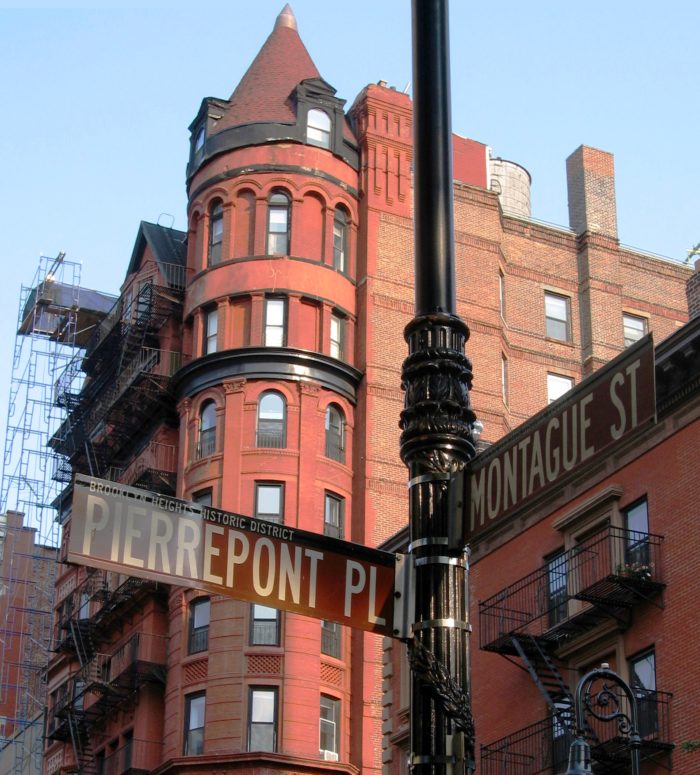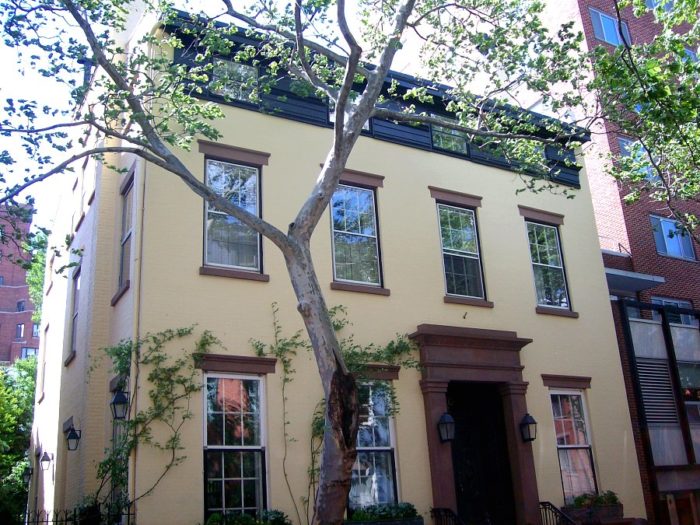When it comes to number of writers per square foot, few areas could rival 20th-century Brooklyn Heights. The neighborhood was home to numerous best-selling authors, several Pulitzer Prize winners, and even a Nobel laureate.
The first wave of literary residents arrived in the 1920s. In 1924 poet Hart Crane moved to 110 Columbia Heights, by Orange Street. The house no longer exists; it was one of many demolished in the 1950s to make way for the Brooklyn-Queens Expressway. Crane rhapsodized about his views of the Brooklyn Bridge and the Statue of Liberty—views that influenced, if not inspired, his magnum opus, “The Bridge.” (Ironically, Washington Roebling, the chief engineer of the Brooklyn Bridge from 1869 through 1883, had during much of the bridge’s construction lived in the same room that Crane rented.) For a time one of Crane’s housemates at 110 Columbia was another writer: John Dos Passos. It was here that Dos Passos began work on one of his best-known works, “Manhattan Transfer.”
Horror writer H.P. Lovecraft also started one of his best-known pieces, the short story “The Call of Cthulhu,” while living in the neighborhood, at 169 Clinton Street (at State Street). Unfortunately Lovecraft’s mid-‘20s stint in Brooklyn Heights also inspired one of his lesser—and most xenophobic—tales, “The Horror at Red Hook.” Anyone familiar with the story, in which Lovecraft makes clear his disdain for the area’s immigrant population, will not be surprised to learn that after 16 unhappy months he left Brooklyn for good in 1926.
H.P. Lovecraft spent an unhappy 16 months at 169 Clinton Street. Image: Eden, Janine, and Jim/Flickr
Another Brooklyn Heights resident at that time was Henry Miller, who would go on to write “Tropic of Cancer” and “Tropic of Capricorn.” For about a year Miller and his wife lived at 91 Remsen Street (between Hicks and Henry Streets) before being evicted for a failure to pay rent. After their 1925 eviction the couple briefly lived in a garden apartment just a few blocks away, then bounced around throughout Brooklyn and Manhattan, returning to the neighborhood in 1926. Miller stayed in several Brooklyn Heights apartments, with and without his wife and her lover, until moving to Paris in 1930.
Thomas Wolfe lived in several Brooklyn Heights apartments during the mid-1930s, including Five Montague Terrace (between Montague and Remsen Streets) and 110 Columbia Heights, the one-time abode of Crane and Dos Passos. During this time he labored over “Of Time and River,” the follow-up to his best-selling debut novel, “Look Homeward Angel.”
But it was in the 1940s that the neighborhood really became known as a writers’ haven, thanks in large part to George Davis. An editor at “Harper’s Bazaar” and, later, “Mademoiselle” magazines at a time when they published fiction, Davis moved into Seven Middagh Street in 1940 with the idea of transforming the home into an artists’ commune. His initial housemates at what would be dubbed February House were Carson McCullers, hot off the success of “The Heart Is a Lonely Hunter,” and W.H. Auden. Auden, who would win the Pulitzer Prize for Poetry in 1947, had already been living in the neighborhood for a year, at One Montague Terrace, but he could no longer afford to live on his own.
W.H. Auden lived at One Montague Terrace for a year before moving into February House. Image: Allison Meier/Flickr
The fourth original roommate was the burlesque star Gypsy Rose Lee, whose childhood formed the basis of the musical “Gypsy.” It was not her literary credentials that gained her admittance; she was a childhood friend of Davis’s. Nonetheless while living in the house Davis helped Lee with her 1941 novel, “The G-String Murders.” When she moved out that year, Richard Wright, whose novel “Native Son” was the first U.S. best-seller written by an African American, moved in. Other residents of February House during its five-year existence included writers Paul and Jane Bowles; artist Salvador Dalí and his wife, Gala; and composers Aaron Copeland, Leonard Bernstein, and Benjamin Britten, the last of whom moved in with his partner, tenor Peter Pears. Once World War II ended, however, Robert Moses seized the house by eminent domain and razed it, just as much of Columbia Heights was razed, to make way for the BQE. Where February House once stood is now part of the on-ramp to the expressway.
World War II brought Norwegian novelist Sigrid Undset to Brooklyn Heights. The winner of the 1928 Nobel Prize for Literature, best known for the “Kristin Lavransdatter” trilogy, was an outspoken opponent of the Nazis; when they invaded Norway in 1940, she fled to the U.S., residing in the Hotel Margaret at the corner of Columbia Heights and Orange Street. At one time the tallest building in the area, the hotel burned down in 1980. The address, 97 Columbia Heights, is now home to a 12-story apartment building that until 2017 was owned by the Jehovah’s Witnesses.
Arthur Miller moved into Brooklyn Heights the same year at Undset. He, his first wife, and several roommates rented an apartment at 62 Montague Street (between Montague Terrace and Hicks Street). The Millers then moved to another apartment in the neighborhood, at 18 Schermerhorn Street (between Clinton and Court Streets); a few years later they moved once again while remaining in the neighborhood. At this residence, 102 Pierrepont Street (between Henry and Clinton Streets), the Millers lived on the floor below a Mr. and Mrs. Mailer, parents of Norman, who stayed with them for a short time after graduating from Harvard in 1943. It was while living on Pierrepont Street that Miller wrote his first major success, “All My Sons.” Its proceeds enabled him and his family to buy a brownstone at 31 Grace Court, several blocks away. The Millers lived on the top two floors and rented out the bottom two. During this time Miller finished his Pulitzer Prize-winning “Death of a Salesman.” When the Millers moved to their fifth Brooklyn Heights home, at 155 Willow Street (between Clark and Pierrepont Streets) in 1951, they sold the Grace Court brownstone to civil-rights activist and author W.E.B. DuBois. Miller wrote “The Crucible” in his Willow Street office. Although he moved out in 1955, a year before marrying Marilyn Monroe, his family remained in the home.
Arthur Miller’s first Brooklyn Heights residence was an apartment at 62 Montague Street. Image: Aude/Wikimedia
Miller lived in Brooklyn Heights for 15 years; Norman Mailer called the neighborhood home for most of his adult life. After his post-World War II discharge from the Army, he moved with his first wife to 49 Remsen Street (between Montague Terrace and Hicks Street). Around the corner, in 62 Montague Terrace, was the attic studio where he wrote his first novel, “The Naked and the Dead.” Published in 1948, it was the only one of his 12 novels to top the “New York Times” best-seller list. In 1960, he moved to the top-floor apartment of 142 Columbia Heights (between Pineapple and Clark Streets), which he owned until his death in 2007. Shortly after moving in, he stabbed his second wife, artist Adele Morales, in the breast and the back during a party at the house, after which he was involuntarily committed to Bellevue Hospital for 17 days. The apartment later became notorious for a far less gory reason: In an effort to combat his fear of heights, Mailer jerry-rigged a series of balconies and crow’s nests within the unit, going so far as to have the roof lifted. Unfortunately it was unclear whether these additions were legal, which created difficulties when his estate put the two-bedroom apartment on the market. On the plus side, Mailer completed his 1979 Pulitzer-winning novel, “The Executioner’s Song,” there.
Truman Capote rented a basement apartment at 70 Willow Street for 10 years. Image: Allison Meier/Flickr
While Mailer may have lived in Brooklyn Heights longer than any other writer, Truman Capote was arguably the most enamored of the neighborhood. From 1955 to 1965, Capote rented a basement apartment in 70 Willow Street (at Pineapple Street), a home built in 1839. (His landlord, Tony-winning scenic designer Oliver Smith, had lived for a while at February House.) Just as Crane, Dos Passos, and Arthur Miller wrote their most successful works in Brooklyn Heights, so did Capote: “Breakfast at Tiffany’s” and “In Cold Blood.” Among other pieces Capote wrote while living here was an essay for “Holiday” magazine in 1959 titled “Brooklyn Heights: A Personal Memoir.” The first lines of this paean to the neighborhood are “I live in Brooklyn. By choice”—a sentiment unusual back then but common today.






